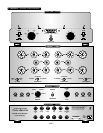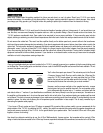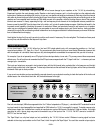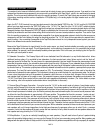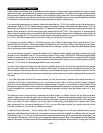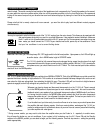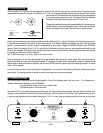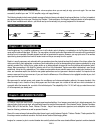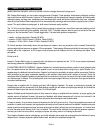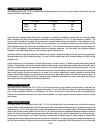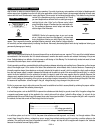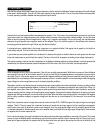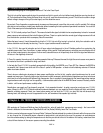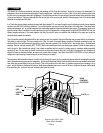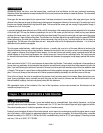
PAGE 10
genetic traits into a new hybrid - such as a rose with no thorns but bigger flowers and stronger scent.
With Tandem-State Imaging, you can combine varying amounts of Pentode / Triode operation simultaneously, effectively creating a
sonic hybrid that marries the harmonic “rightness” of Triode operation with the dynamics and frequency extension of Pentode power;
midrange lushness and bass slam; transparency plus soundstage width; contol with finesse. Astute audio critics have repeatedly
stated in print that Tandem-State Imaging results in an uncommon quality, seemingly neither solid-state nor typically tube, but rather...
musical. This would validate our design goal: to build musical instrument quality amplifiers.
The TIGRIS is a push-pull design, utilizing 6 power tubes per channel, arranged in two rows of three, each row amplifying one half
of the wave form, phase-split by the preceding dual-triode 12AX7. The power tubes are wired in pairs into one each of the three
positions of the front-mounted Triode / Pentode toggle switch. The three switch positions correspond to:
• inwards = all three pairs wired in Pentode (35 W/Ch)
• upwards = 2 EL84, 2 6V6 in Pentode / 2 EL84 in Triode (28 W/Ch)
• outwards = 2 EL 84, 2 6V6 in Triode / 2 EL84 in Pentode (20 W/Ch)
All Pentode operation demonstrably widens the soundstage and creates a front row perspective, while increased Triode activitiy
reduces stage width and assumes an apparent 10th row perception. These imaging differences are initially the most easy to discern,
followed, with a little experience, by the change of tonal character and the emphasis shift into the midrange with higher Triode
participation.
But that’s not all.
Inherent in Tandem-State Imaging is a second function that allows you to optimally tune the TIGRIS to your system requirements
and listening preferences: adjustable Negative Feedback.
B: ADJUSTABLE NEGATIVE FEEDBACK - Negative Feedback is a corrective technique wherein a portion of signal voltage is taken
from the speaker terminal and fed back into the amplifier’s input, but out-of-phase with the original input signal. Because it is of
opposite phase, the feedback is termed inverse or “Negative” and it works by cancellation to reduce amplifier inaccuracies. Distortion
would be defined as any signal components appearing at the amplifier’s output which weren’t present at the input. Picture the
cancellation effect of Negative Feedback as being equivalent to a reduction in circuit gain: the amount of output of both distorted and
non-distorted signal, is reduced. Thus by feeding back a part of the output voltage to the input, out-of-phase, circuit gain and distortion
are reduced simultaneously.
Example: take an amplifier with 2% distortion and add 6 dB of Negative Feedback. The output, a combination of distorted and
undistorted signal, will then be reduced by half. Now doubling amplifier gain will restore the original signal strength, but the distortion
element will remain halved and now only constitute 1% of the total signal.
Negative Feedback would theoretically seem an ideal measure to design an amplifier with zero distortion, by simply applying the
requisite amounts of feedback. However, high amounts of feedback, while indeed measuring well in the lab, don’t work well in the
musical performance domain because minute micro-information about the original event becomes veiled .
It is easy to see why. For a corrective measure to become active, the fault has to occur first. If the time-lag between occurrence and
correction is a matter of milli-seconds, then signal portions of exactly such milli-second duration will be affected. Feedback never quite
catches up with the changing musical signal and tends to obscure inner detail, ambient cues and micro dynamics - all of which alerts
our brain that what we are listening to isn’t real, but artificial. This would be the antithesis of what high-end equipment aspires to:
convincing our brain that real musicians, occupying real space, are making music in our listening environments.
Thus, Negative Feedback must be used sparingly, as a subtle calibration device rather than a cheap perfume to hide flaws of a poorly
designed circuit. A properly designed amplifier needs to work well without any feedback to begin with.
5 - 1 TANDEM STATE IMAGING: ( Continued )



